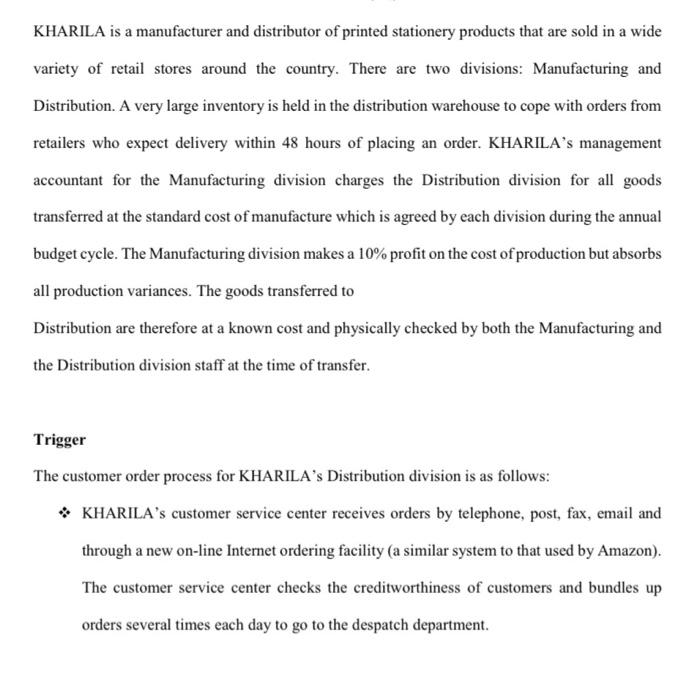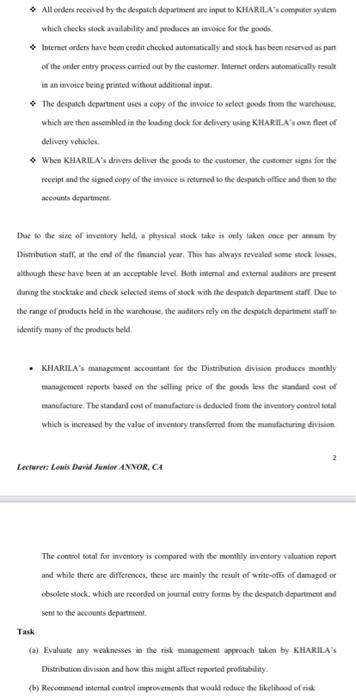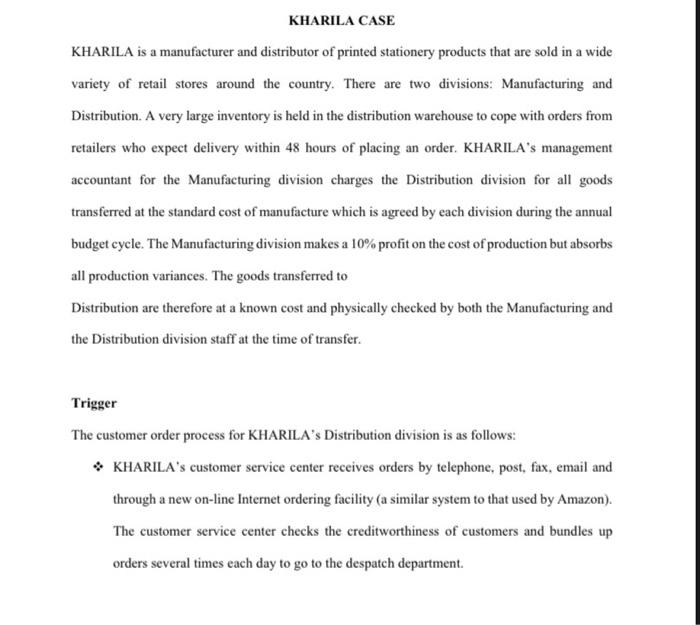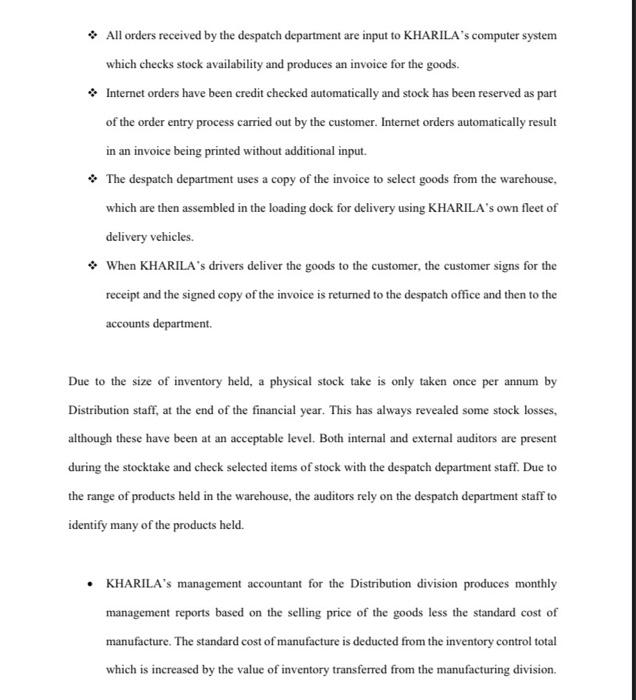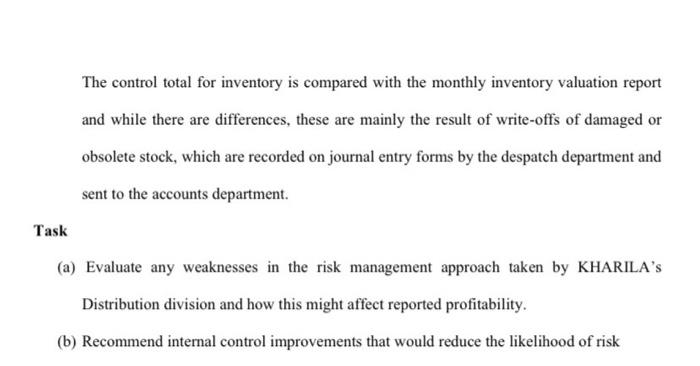KHARILA is a manufacturer and distributor of printed stationery products that are sold in a wide variety of retail stores around the country. There are two divisions: Manufacturing and Distribution. A very large inventory is held in the distribution warehouse to cope with orders from retailers who expect delivery within 48 hours of placing an order. KHARILA's management accountant for the Manufacturing division charges the Distribution division for all goods transferred at the standard cost of manufacture which is agreed by each division during the annual budget cycle. The Manufacturing division makes a 10% profit on the cost of production but absorbs all production variances. The goods transferred to Distribution are therefore at a known cost and physically checked by both the Manufacturing and the Distribution division staff at the time of transfer. Trigger The customer order process for KHARILA's Distribution division is as follows: KHARILA's customer service center receives orders by telephone, post, fax, email and through a new on-line Internet ordering facility (a similar system to that used by Amazon). The customer service center checks the creditworthiness of customers and bundles up orders several times each day to go to the despatch department. All onders received by the despatch department are input to KHARILA's.computer system which checks stock availability and produces a invoice for the goods. Internet orders have been credit checked automatically and stock has been reserved as part of the order entry process carried out by the customer. Internet onders automatically result in an invoice being printed without additional input. The despatch department uses a copy of the invoice to select goods from the warehouse, which are then assembled in the loading dock for delivery using KHARILA'You fleet of delivery vehicles When KHARILA's drivers deliver the goods to the customer, the customer signs for the receipt and the signed copy of the invoice is returned to the despurch office and them to the accounts department Due to the site of inventory held, a physical stock take is only taken once per annum by Distribution staff at the end of the financial year. This has always revealed some stuck lowes although these have been at an acceptable level. Toth internal and external auditors are present during the stocktake and check selected items of stock with the despatch department staff. Due to the range of products held in the warcherase, the matters rely on the despatch department staff Identity many of the products belt KHARILA'S management accountant for the Distribution division produces monthly management reports based on the selling price of the good less the standard cost er manufacture. The standard cost of manufacture is deducted from the inventory control total which is increased by the value of inventory transferred from the manufacturing division. Lecturer: Louis David Junior ANNOR, CA The control total for inventory is compared with the monthly inventory valuation report and while there are differences, these are mainly the result of write-offs of damaged ore obsolete stock, which are recorded on journal entry forms by the despatch department and sent to the accounts department Task (a) Evaluate any weaknesses in the risk management approach taken by KHARILAS Distribution division and how this might affect reported profitability (b) Recommend internal control improvements that would reduce the likelihood of tick KHARILA CASE KHARILA is a manufacturer and distributor of printed stationery products that are sold in a wide variety of retail stores around the country. There are two divisions: Manufacturing and Distribution. A very large inventory is held in the distribution warehouse to cope with orders from retailers who expect delivery within 48 hours of placing an order. KHARILA's management accountant for the Manufacturing division charges the Distribution division for all goods transferred at the standard cost of manufacture which is agreed by each division during the annual budget cycle. The Manufacturing division makes a 10% profit on the cost of production but absorbs all production variances. The goods transferred to Distribution are therefore at a known cost and physically checked by both the Manufacturing and the Distribution division staff at the time of transfer. Trigger The customer order process for KHARILA's Distribution division is as follows: KHARILA's customer service center receives orders by telephone, post, fax, email and through a new on-line Internet ordering facility (a similar system to that used by Amazon). The customer service center checks the creditworthiness of customers and bundles up orders several times each day to go to the despatch department. The control total for inventory is compared with the monthly inventory valuation report and while there are differences, these are mainly the result of write-offs of damaged or obsolete stock, which are recorded on journal entry forms by the despatch department and sent to the accounts department. Task (a) Evaluate any weaknesses in the risk management approach taken by KHARILA's Distribution division and how this might affect reported profitability. (b) Recommend internal control improvements that would reduce the likelihood of risk KHARILA is a manufacturer and distributor of printed stationery products that are sold in a wide variety of retail stores around the country. There are two divisions: Manufacturing and Distribution. A very large inventory is held in the distribution warehouse to cope with orders from retailers who expect delivery within 48 hours of placing an order. KHARILA's management accountant for the Manufacturing division charges the Distribution division for all goods transferred at the standard cost of manufacture which is agreed by each division during the annual budget cycle. The Manufacturing division makes a 10% profit on the cost of production but absorbs all production variances. The goods transferred to Distribution are therefore at a known cost and physically checked by both the Manufacturing and the Distribution division staff at the time of transfer. Trigger The customer order process for KHARILA's Distribution division is as follows: KHARILA's customer service center receives orders by telephone, post, fax, email and through a new on-line Internet ordering facility (a similar system to that used by Amazon). The customer service center checks the creditworthiness of customers and bundles up orders several times each day to go to the despatch department. All onders received by the despatch department are input to KHARILA's.computer system which checks stock availability and produces a invoice for the goods. Internet orders have been credit checked automatically and stock has been reserved as part of the order entry process carried out by the customer. Internet onders automatically result in an invoice being printed without additional input. The despatch department uses a copy of the invoice to select goods from the warehouse, which are then assembled in the loading dock for delivery using KHARILA'You fleet of delivery vehicles When KHARILA's drivers deliver the goods to the customer, the customer signs for the receipt and the signed copy of the invoice is returned to the despurch office and them to the accounts department Due to the site of inventory held, a physical stock take is only taken once per annum by Distribution staff at the end of the financial year. This has always revealed some stuck lowes although these have been at an acceptable level. Toth internal and external auditors are present during the stocktake and check selected items of stock with the despatch department staff. Due to the range of products held in the warcherase, the matters rely on the despatch department staff Identity many of the products belt KHARILA'S management accountant for the Distribution division produces monthly management reports based on the selling price of the good less the standard cost er manufacture. The standard cost of manufacture is deducted from the inventory control total which is increased by the value of inventory transferred from the manufacturing division. Lecturer: Louis David Junior ANNOR, CA The control total for inventory is compared with the monthly inventory valuation report and while there are differences, these are mainly the result of write-offs of damaged ore obsolete stock, which are recorded on journal entry forms by the despatch department and sent to the accounts department Task (a) Evaluate any weaknesses in the risk management approach taken by KHARILAS Distribution division and how this might affect reported profitability (b) Recommend internal control improvements that would reduce the likelihood of tick KHARILA CASE KHARILA is a manufacturer and distributor of printed stationery products that are sold in a wide variety of retail stores around the country. There are two divisions: Manufacturing and Distribution. A very large inventory is held in the distribution warehouse to cope with orders from retailers who expect delivery within 48 hours of placing an order. KHARILA's management accountant for the Manufacturing division charges the Distribution division for all goods transferred at the standard cost of manufacture which is agreed by each division during the annual budget cycle. The Manufacturing division makes a 10% profit on the cost of production but absorbs all production variances. The goods transferred to Distribution are therefore at a known cost and physically checked by both the Manufacturing and the Distribution division staff at the time of transfer. Trigger The customer order process for KHARILA's Distribution division is as follows: KHARILA's customer service center receives orders by telephone, post, fax, email and through a new on-line Internet ordering facility (a similar system to that used by Amazon). The customer service center checks the creditworthiness of customers and bundles up orders several times each day to go to the despatch department. The control total for inventory is compared with the monthly inventory valuation report and while there are differences, these are mainly the result of write-offs of damaged or obsolete stock, which are recorded on journal entry forms by the despatch department and sent to the accounts department. Task (a) Evaluate any weaknesses in the risk management approach taken by KHARILA's Distribution division and how this might affect reported profitability. (b) Recommend internal control improvements that would reduce the likelihood of risk
